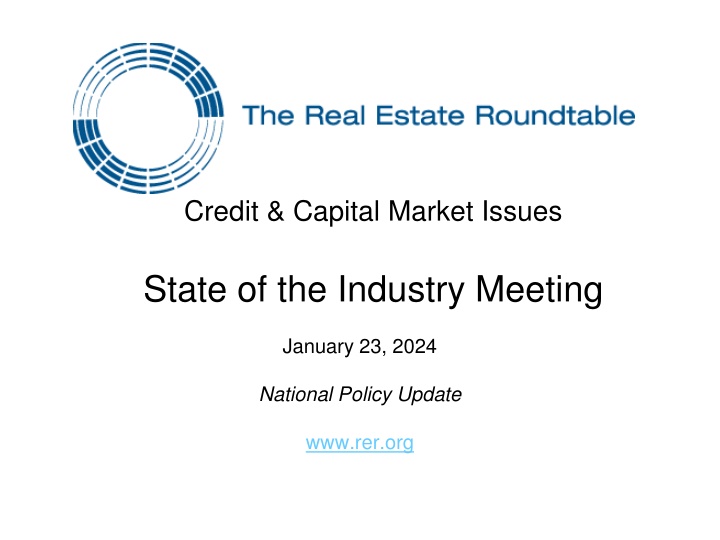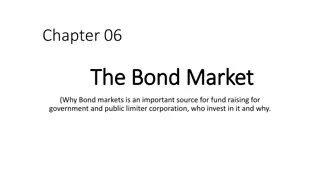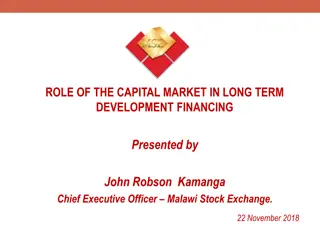Current Challenges Facing Credit and Capital Markets
Risks to the economic outlook are mounting due to various factors such as Federal Reserve rate raises, inflation nearing the Fed target, and concerns about a recession. Specifically, the commercial real estate (CRE) sector is facing liquidity concerns with a significant amount of debt maturing in the coming years. Additionally, proposed regulations like Basel III could further impact credit markets and capital formation, leading to increased costs and constraints on lending capacity.
Download Presentation

Please find below an Image/Link to download the presentation.
The content on the website is provided AS IS for your information and personal use only. It may not be sold, licensed, or shared on other websites without obtaining consent from the author.If you encounter any issues during the download, it is possible that the publisher has removed the file from their server.
You are allowed to download the files provided on this website for personal or commercial use, subject to the condition that they are used lawfully. All files are the property of their respective owners.
The content on the website is provided AS IS for your information and personal use only. It may not be sold, licensed, or shared on other websites without obtaining consent from the author.
E N D
Presentation Transcript
Credit & Capital Market Issues State of the Industry Meeting January 23, 2024 National Policy Update www.rer.org
Risks to Economic Outlook Since March 2022, 11 Fed rate raises, some 525 bps Fed left rates unchanged in Dec. 22-year high; target FF range of 5 to 5 % next FOMC meeting Jan 30 10-yr UST hit 5% in Nov. 16 year high: peak? Inflation: 3.4% - within striking distance of Fed target 2% Economy strong: 4.9% growth in Q3; unemployment at 3.7% Recession concerns: soft landing? US budget drama, $34 trillion debt; $1 trillion run rate Conflict: Ukraine, Israel, Yemen, Taiwan Natural catastrophe risk and insurance premium spikes Cyber and terrorist threats; border security
CRE Liquidity Concerns Uncertainty about future office demand, impact on fundamentals, valuations, and credit remains main focus of CRE, CMBS markets Of the $5.82 trillion CRE debt outstanding, over half $2.75 trillion is maturing over next 4 years some 50.6% held by commercial banks Bank delinquency rate for CRE loans was 1.14% in Q3 of 2023, over twice the 0.53% in the Q3 of 2022 Overall CRE lending already diminished, including new issuance of CMBS down by 18% from 2022 SASB CMBS down 58% and CRE CLOs down by 78% liquidity available, but it s likely going to be more expensive, with lower leverage Capital essential to restructure wave of maturities
Perfect Storm of Regulation Increasing concern about potential perfect storm of proposed regulations that could further stall credit markets and impair capital formation Basel III Endgame capital hikes could increase cost of credit, further diminish lending capacity, undermine essential role banks play in real estate lending SEC has various proposed rulemaking measures that could have a chilling effect on real estate capital formation vital to help restructure maturing debt, fill equity gap Death by a thousand cuts for real estate capital markets These proposed regulations come at a significant economic cost without clear benefits to economy
CRE Liquidity Concerns Basel III Proposed Rule Basel III endgame would increase capital requirements for largest banks by as much as 20% Most consequential change to US banking regulation since Dodd-Frank will increase cost of credit and constrain capacity Former Fed Vice Chair Randy Quarles, warned it is a "mistake , saying, It will restrict the ability of the financial system to provide support for the real economy Since 2009, Tier 1 capital has increased by 56% and Common Equity Tier 1 capital has tripled. As Fed recently observed: banking system is sound and resilient, with strong capital and liquidity. At this critical time, it is important that the Agencies do not engage in such pro-cyclical policies Jan. 12 Roundtable comment letter to Fed urges revision and re-proposal of Basel III endgame rules
Endgame Recourse Concerns Basel III Endgame proposal would change how a defaulted mortgage is defined, including exposure to the borrower Most CRE lending is structured on non-recourse basis, permitting lender to seize only collateral specified in the loan agreement, even if its value does not cover the entire debt Under Endgame proposal, the bank must analyze overall exposure to borrower, beyond specific loan; assign a 150% risk weight to any defaulted loan and essentially all other loans to the same borrower (even if current). As such, it raises concerns about maintaining integrity of non-recourse lending agreements Instead, regulators should focus on additional measures to help restructure and transition the ownership and financing of commercial real estate from a period of low rates and robust markets to a time of higher rates, declining credit capacity and uncertain economic growth
SEC Proposed Custody Rule Safeguarding Advisory Client Assets would significantly expand requirements of Custody Rule to maintain client assets with a qualified custodian for certain physical assets such as real estate Could severely impact advisory clients ability to invest in real estate. Roundtable seeking real estate exception Ample safeguards already exist to promote the safe-keeping of real estate assets held in advisory accounts or funds, which assets are not subject to high risk of loss or theft SEC has not coherently explained how Proposed Rule would apply to real estate seeking exception for real estate RER Custody Rule Working Group met recently with SEC Investment Management team; comment letter submitted
RER Policy Response March 17 RER letter requested federal bank regulators to reestablish immediately a troubled debt restructuring program for commercial real estate that would give financial institutions increased flexibility to refinance loans with borrowers and lenders June policy statement from regulatory agencies encourages financial institutions to work constructively with creditworthy borrowers on CRE loan workouts to see loans through current environment According to a recent Trepp research report, some $5.65 billion in commercial real estate loans have already been restructured this year Additional capital is vital to rebalance maturing loans
RER Policy Response To help rebalance this wave maturing loans, it is important to advance measures that will encourage additional capital formation To that end, it is essential to bring more foreign capital into U.S. real estate by lifting legal barriers to investment, as well as to repeal or reform the archaic Foreign Investment in Real Property Tax Act (FIRPTA) Fed should also consider reviving the Term Asset Backed Securities Lending Facility (TALF) for Legacy CMBS Importantly, policymakers must not hike the tax rate on capital gains, end carried interest, or alter the 1031 like- kind exchange provisions
Foreign Investment In U.S. Real Estate Over half of U.S. states have either implemented or proposed legislation restricting foreign ownership of real property Florida Senate Bill 264 (SB 264) prohibits Chinese investors from directly or indirectly acquiring anyinterest in real property unless such interest is de minimis. It also imposes restrictions on investors from Russia, North Korea, Cuba, Venezuela and Syria, precluding them from acquiring any interest in agricultural land or real property within 10 miles of any military installation or critical infrastructure facility RER comments focused on U.S. managed investment funds, that may now be precluded from pursuing investment opportunities in Florida if there is any level of investor participation in the fund even passive, minority interests from countries of concern like China
Corporate Transparency Act CTA enacted on Jan. 1, 2021 as part of NDAA to prevent use of companies to evade anti-money laundering rules, illegal activities Unprecedented government collection of information CTA requires Treasury s Financial Crimes Enforcement Network (FinCEN) to develop a confidential, secure, and non-public database to maintain reported beneficial ownership information Effective on Jan. 1, 2024, the CTA s beneficial ownership information (BOI) Rule require certain entities to file reports with FinCEN identifying and providing information about their beneficial owners In comments to FinCen, the Roundtable and others raised concerns that the CTA could result in an outcome of confusion, missteps, and ultimately fines on law-abiding businesses Roundtable continues to work with policymakers to find a balanced approach that would inhibit illicit money laundering activity without imposing additional and costly reporting requirements on real estate
Affordable Housing U.S. housing production not keeping pace with rising housing needs; shortage of over 5.5 million units, hindering low-income individuals from finding housing Vital to enact policies that will help grow America s housing infrastructure; halt rent control measures LIHTC is an important source of federal funding for affordable housing Current compromise increases supply of low-income housing by enhancing the LIHTC, with increased state allocations and a reduced tax-exempt bond financing requirement critical for expanding housing infrastructure Enacting conversion incentives Affordable Housing Credit Improvements Act, Revitalizing Down-towns Act
Office The Covid-19 pandemic triggered challenges for the office sector, with national vacancy rate soaring to 13.5% USG and labor unions key drivers in the WFH culture Roundtable continues to press for return to work and incentives for commercial conversion to residential measures Affordable Housing Conversion Act (Sen. Stabenow-Rep. Carey) would compliment regulatory/zoning/land use changes and property tax abatement efforts at state and local level Create a transferable tax credit to convert older, underutilized commercial real estate to housing Stabenow-Carey draft bill modeled on historic rehabilitation tax credit Legislation builds on White House plan to provide loan guarantees and financing for private sector conversion projects
Credit & Capital Market Issues State of the Industry Meeting January 23, 2024 National Policy Update www.rer.org























